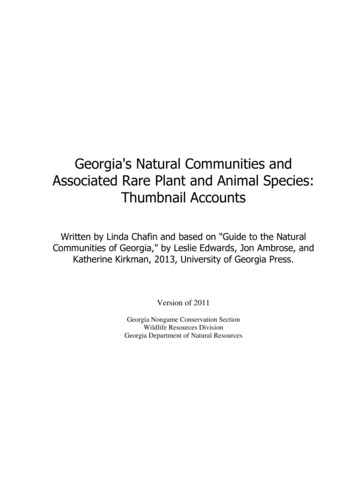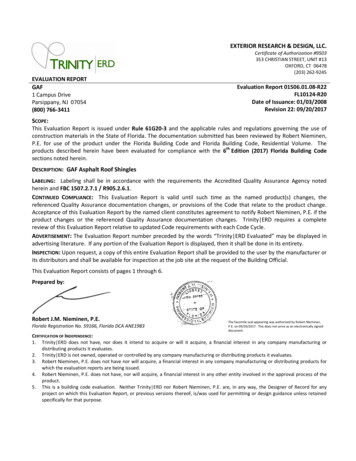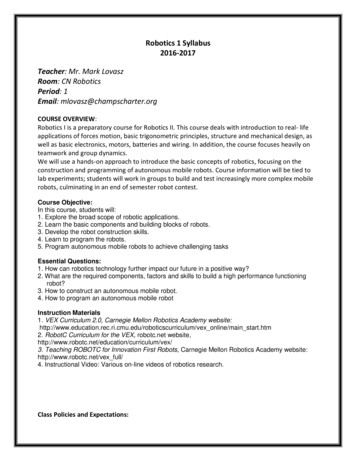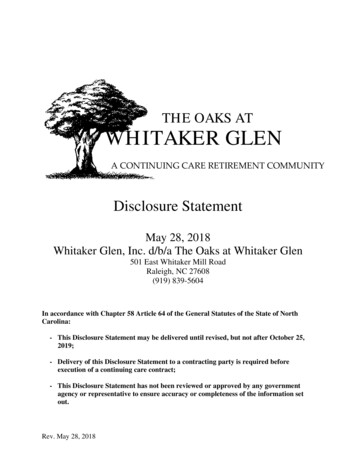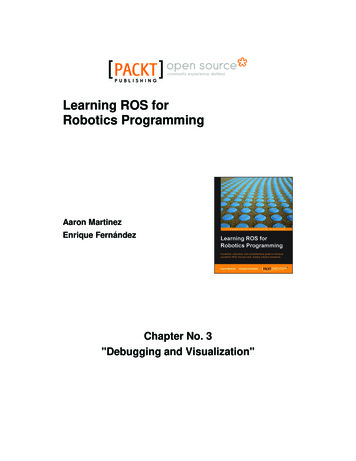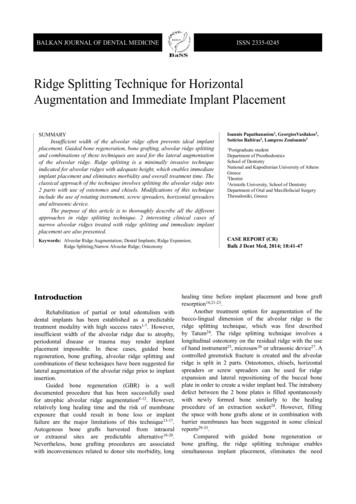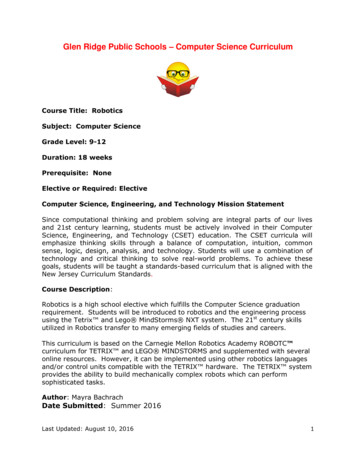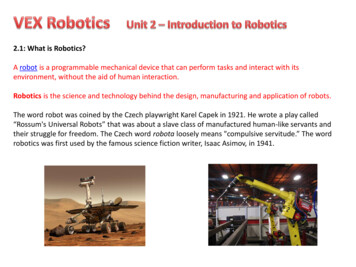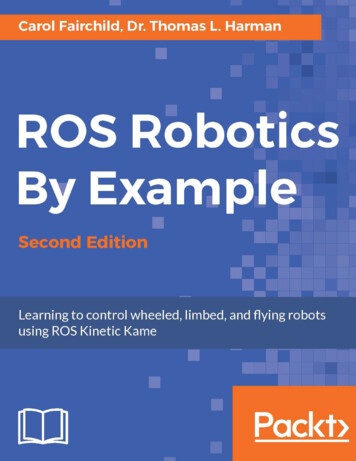
Transcription
Course Title: RoboticsSubject: Mathematics/Computer ScienceGrade Level: 9 - 12Duration: 18 weeksPrerequisite: NoneElective or Required: ElectiveMathematics Mission StatementstSince Mathematical and Computational thinking are an integral part of our lives and 21 Centurylearning, students must be actively involved in their mathematics education with problem solvingbeing an essential part of the curriculum. The mathematics and computer science curricula willemphasize thinking skills through a balance of computation, intuition, common sense, logic,analysis and technology.Students will be engaged and challenged in a developmentally appropriate, student-centeredlearning environment. Students will communicate mathematical ideas effectively and apply thoseideas by using manipulatives, computational skills, mathematical models and technology in orderto solve practical problems.To achieve these goals, students will be taught a standards-based curriculum that is aligned withthe National Common Core Standards in Mathematics and the New Jersey Core CurriculumstContent Standards in Technology and 21 Century Life and Careers.Course Description:Robotics is a high school elective which fulfills the Computer Science graduation requirement.Students will be introduced to robotics and the engineering process using the Tetrix and Lego stMindStorms NXT system. The 21 century skills utilized in Robotics transfer to many emergingfields of studies and careers.The course will use the Carnegie Mellon Robotics Academy ROBOTC curriculum for TETRIX and LEGO MINDSTORMS. RobotC is a robotics language developed by Carnegie MellonUniversity. The TETRIX system provides the ability to build mechanically complex robotswhich can perform sophisticated tasks. The Tetrix building system utilizes the LEGO MINDSTORMS NXT brick (considered the “brain” of the robot) to control the sensors andmechanical parts of the robot.Author: Mayra BachrachDate Submitted: Summer 20121
Curriculum StandardsCommon Core English Language Standards for Science and Technical subjects:RST.9-10.3. Follow precisely a complex multistep procedure when carrying out experiments,taking measurements, or performing technical tasks, attending to special cases or exceptionsdefined in the text.RST.9-10.4. Determine the meaning of symbols, key terms, and other domain-specific words andphrases as they are used in a specific scientific or technical context relevant to grades 9–10 textsand topics.RST.9-10.10. By the end of grade 10, read and comprehend science/technical texts in the grades9–10 text complexity band independently and proficiently.RST.11-12.3. Follow precisely a complex multistep procedure when carrying out experiments,taking measurements, or performing technical tasks; analyze the specific results based onexplanations in the text.RST.11-12.4. Determine the meaning of symbols, key terms, and other domain-specific wordsand phrases as they are used in a specific scientific or technical context relevant to grades 11–12texts and topics.RST.11-12.10. By the end of grade 12, read and comprehend science/technical texts in thegrades 11–12 text complexity band independently and proficiently.Common Core Math Standards:N-Q-1: Use units as a way to understand problems and to guide the solution of multi-stepproblems; choose and interpret units consistently in formulas; choose and interpret the scale andthe origin in graphs and data displays.G-MG-3: Apply geometric methods to solve design problems (e.g., designing an object orstructure to satisfy physical constraints or minimize cost; working with typographic grid systemsbased on ratios).Technology Standards:8.1 All students will use digital tools to access, manage, evaluate and synthesize information inorder to solve problems individually and collaboratively and to create and communicateknowledgeA. Technology Operations and ConceptsB. Creativity and Innovation21st Century Life and Career Education9.1. All students will demonstrate the creative, critical thinking, collaboration and problem solvingskills needed to function successfully as global citizens and workers in diverse ethnic andorganizational cultures.A. Critical Thinking and Problem SolvingB. Creativity and InnovationC. Collaboration, Teamwork and LeadershipF. Accountability, Productivity and Ethics2
RoboticsUnit 1: NXT robot ConstructionApproximate # Of Weeks: 1 weekEssential Questions: What is a Robot?What is engineering?What is the engineering process?What are the main hardware components of a Lego MindStorms NXT system?How do the physical parts of a Lego MindStorms NXT robot fit together?What are the steps to construct a Lego MindStorms NXT robot?How are the ports and sensors on the NXT robot related?What is firmware?How is a robot able to perform tasks?What is programming?What are the main components of the RobotC programming environment?Upon completion of this unit students will be able to: Explain what a robot is.Explain what engineering is.Explain and use the engineering process.Describe applications of robotics.Identify the components of the Lego Mindstorms NXT system and explain their function.Identify the parts of a Lego Mindstorms NXT robot construction kit.Construct the Lego Mindstorms NXT Rem Bot Robot.Explain and connect ports of the NXT Robot with its sensors.Explain what programming is and how it is used to control the NXT robot.Explain and download the RobotC firmware.Identify and demonstrate the use of the RobotC programming software.Use the RobotC programming environment to download and run a sample program onthe NXT robot.Interdisciplinary Standards: 8.1 A, B, 9.1 A, B, C, F, RST.9-10.3, RST.9-10.4, RST.9-10.10, RST.11-12.3, RST.1112.4, RST.11-12.10Activities: Lecture and class discussion.RobotC video trainer exercisesDownload and install the RobotC firmware on the NXT.Build the NXT robot from its component parts.Using the RobotC programming environment, download and run a sample program to theNXT.Class blog entries in response to teacher prompts.3
Enrichment Activities: Project: Students will create a short PowerPoint presentation on the history of Robotics.What is a Robot? (Classroom Activities for the Busy Teacher).Methods of Assessments/Evaluation: NXT robot building projectRobotC Video Trainer exercisesQuizzesTestsResponses to discussion questionsVerbal assessmentThink/Pair/ShareThumbs up/Thumbs downExit slipsResources: Carnegie Mellon Robotics Academy RobotC Video TrainerClassroom Activities for the Busy Teacher: NXT 2nd Edition, Kee, DamienYoutube at http://www.youtube.com/Teachertube at http://www.teachertube.comTeacher created class resources on GRHS serverTeacher Webpage4
RoboticsUnit 2: Moving and TurningApproximate # Of Weeks: 2 weeksEssential Questions: What is the structure of a RobotC program?What is the format of a RobotC programming statement?What are the basic syntax rules of the RobotC programming language?How can a robot be instructed to move forward or backward?How can a robot be instructed to move a specified distance using timing?How can a robot be instructed to move a specified distance using the motor encoders?How can a robot be instructed to stop when moving?How can the speed of a robot be controlled?What is the PID algorithm and how is it used by the NXT?What is a point turn and how is it programmed?What is a swing turn and how is it programmed?Which RobotC programming statements are used to make the NXT robot moveforward/backward for a specified distance at a given speed?What are the RobotC programming statements used to synchronize two motors?Upon completion of this unit students will be able to: Explain the basic structure of a RobotC program.Explain and comply with the syntax rules of the RobotC programming language.Explain and use the RobotC programming statements to instruct a robot to move aspecified distance using timing.Explain and use the RobotC programming statements to instruct a robot to move aspecified distance using the motor encoder statements.Explain and use RobotC programming statements to instruct a robot to move forward orbackwards.Explain and use RobotC programming statements to control the speed of a robot.Explain and program a point turn.Explain and program a swing turn.Compare and contrast point turns and swing turns.Explain the PID algorithm and how it is used by the NXT.Explain and use the RobotC programming statements to synchronize the NXT motors.Analyze a problem statement requiring robot movement and turning and implement aprogramming solution in RobotC.Interdisciplinary Standards 8.1 A, B, 9.1 A, B, C, F, RST.9-10.3, RST.9-10.4, RST.9-10.10, RST.11-12.3, RST.1112.4, RST.11-12.10, N-Q.1, G-MG.3Activities: Lecture and class discussion.RobotC video trainer exercises5
Wait states engineering lab.Turning engineering lab.Robo-Slalom challenge.Robo 500 challenge.Labyrinth challenge.Engineering journal.Class blog entries in response to teacher prompts.Enrichment Activities: Line Painter challengeHow Fast? activity (Classroom Activities for the Busy Teacher).Methods of Assessments/Evaluation: RobotC Video Trainer exercisesObstacle course challenges.QuizzesTestsResponses to discussion questionsVerbal assessmentThink/Pair/ShareThumbs up/Thumbs downExit slipsResources: Carnegie Mellon Robotics Academy RobotC Video TrainerClassroom Activities for the Busy Teacher: NXT 2nd Edition, Kee, DamienYoutube at http://www.youtube.com/Teachertube at http://www.teachertube.comTeacher created class resources on GRHS serverTeacher Webpage6
RoboticsUnit 3: Move until - using the motor encoders, touch and ultrasonicsensorsApproximate # Of Weeks: 2 weeksEssential Questions: How do robots make decisions?How does an NXT robot detect the distance that it has traveled?How does an NXT robot detect that it has touched an object?How does an NXT robot detect that it is a given distance away from another object?How do the motor encoders (smart motors), touch and ultrasonic sensors work?How are motors and sensors configured in the RobotC programming environment?What is a loop?What are relational operators?What are logical operators?How are loops and sensor values combined to control robot behaviors?What RobotC programming statements are used to make the robot move and then stopwhen it detects that it touched another object?What are the RobotC programming statements used to make the robot move and thenstop when it is a given distance away from another object?What is a threshold and how is it used to control robot behaviors?Upon completion of this unit students will be able to: Describe how the motor encoders (smart motors) work and apply this knowledge toprogramming an NXT robot to move for a specified distance.Describe how the Touch sensor works and apply this knowledge to programming an NXTrobot to move until it touches another object.Describe how the Ultrasonic sensor works and apply this knowledge to programming arobot to move until it is a given distance away or near an object.Explain and use the RobotC motors and sensors set up dialog to configure the NXTmotors and sensors.Explain how robots make decisions.Explain and use thresholds values to program robot behaviors.Explain and program a while loop.Explain and use the relational operators.Explain and use the logical operators, && and .Explain and use RobotC programming statements to instruct the NXT robot to move aspecified distance.Explain and use RobotC programming statements to instruct the NXT robot to move untilit touches another object.Explain and use RobotC programming statements to instruct the NXT robot to move untilit is a give distance near or far from another object.Analyze a problem statement requiring the use of the motor encoders, touch andultrasonic sensors and implement a programming solution in RobotC.7
Interdisciplinary Standards 8.1 A, B, 9.1 A, B, C, F, RST.9-10.3, RST.9-10.4, RST.9-10.10, RST.11-12.3, RST.1112.4, RST.11-12.10, N-Q.1, G-MG.3Activities: Lecture and class discussion.Building the ultrasonic and touch sensor attachments.RobotC video trainer exercisesTurning with encoder engineering lab.CanBot challenge.Robo 500 challenge levels 2 and 3.Engineering journal.Class blog entries in response to teacher prompts.Enrichment Activities: Robo mower challenge.NASA DomaBot basics (Classroom Activities for the Busy Teacher)Methods of Assessments/Evaluation: RobotC Video Trainer exercisesObstacle course challenges.QuizzesTestsResponses to discussion questionsVerbal assessmentThink/Pair/ShareThumbs up/Thumbs downExit slipsResources: Carnegie Mellon Robotics Academy RobotC Video TrainerClassroom Activities for the Busy Teacher: NXT 2nd Edition, Kee, DamienYoutube at http://www.youtube.com/Teachertube at http://www.teachertube.comTeacher created class resources on GRHS serverTeacher Webpage8
RoboticsUnit 4: Sensing light and soundApproximate # Of Weeks: 3 weeksEssential Questions: How does an NXT robot detect quiet or loud?How does an NXT robot detect light or dark?How do the light and sound sensors work?What is a threshold and how is it used to control robot behaviors?How are sensors threshold values calculated and used?What is a timer?How are timers used to program more complex robot behaviors?How are loops and sensor values combined to control robot behaviors?How are if-else conditional statements used to control robot behaviors?How are if-else conditional statements and loops combined to control more complexrobot behaviors?Which RobotC programming statements are used to make the robot move until it hears aloud or quiet?Which RobotC programming statements are used to make the robot move or stop when itdetects light or dark?How can the light sensor be used to program the robot to follow a line?What is an assignment statement?Upon completion of this unit students will be able to: Describe how the light sensor works and apply this knowledge to programming an NXTrobot to move or stop when it detects light or dark.Describe how the sound sensor works and apply this knowledge to programming an NXTrobot to move or stop when it hears loud or quiet.Explain and compute threshold values for the light and sound sensors.Explain and use the RobotC motors and sensors set up dialog to configure the NXTsound and light sensors.Explain and use timers.Explain how robots make decisions.Explain and use thresholds values to program robot behaviors.Explain and use assignment statements.Explain and program a while loop.Explain and program conditional statements (if-else).Explain how while loops and if-else statements can be combined to control more complexrobot behaviors.Explain and program a nested while loop.Explain and use the relational operators.Explain and use the logical operators, && and .Explain and use RobotC programming statements to instruct the NXT robot to move orstop in response to light or dark.Explain and use RobotC programming statements to instruct the NXT robot to move orstop when it detects loud or quiet.Explain and use RobotC programming statements to instruct the NXT robot to follow aline using the light sensor.9
Analyze a problem statement requiring the use of the light and sound sensors andimplement a programming solution in RobotC.Interdisciplinary Standards 8.1 A, B, 9.1 A, B, C, F, RST.9-10.3, RST.9-10.4, RST.9-10.10, RST.11-12.3, RST.1112.4, RST.11-12.10, N-Q.1, G-MG.3Activities: Lecture and class discussion.Building the light and sound sensor attachments.RobotC video trainer exercisesRobo 500 challenge level 4.Line Runner challenge.Mouse Bot challenge.Minefield challenge.Class blog entries in response to teacher prompts.Enrichment Activities: Minesweeper obstacle challenge.Robocci obstacle challenge.Help! I’m Stuck (Classroom Activities for the Busy Teacher)Methods of Assessments/Evaluation: RobotC Video Trainer exercisesQuizzesTestsResponses to discussion questionsVerbal assessmentThink/Pair/ShareThumbs up/Thumbs downExit slipsResources: Carnegie Mellon Robotics Academy RobotC Video TrainerClassroom Activities for the Busy Teacher: NXT 2nd Edition, Kee, DamienYoutube at http://www.youtube.com/Teachertube at http://www.teachertube.comTeacher created class resources on GRHS serverTeacher Webpage10
RoboticsUnit 5: Variables and FunctionsApproximate # Of Weeks: 3 weeksEssential Questions: What is a variable?What are the data types of variables in RobotC?What are the characteristics of variables?How are variables given a value?How are the arithmetic operators represented in RobotC?How are variables used to configure sensor threshold values programmatically?How are variables and arithmetic operators used to count lines?How are if-else conditional statements nested to program complex robot behaviors?How is the RobotC debugger used to find and eliminate program errors?How are messages displayed for the user on the NXT display console?What is a function?What is a parameter?What is a return type?How can functions be used to simplify programming robot behaviors?How do global, local and parameter variables compare?What is the scope of a variable?Upon completion of this unit students will be able to: Explain and use variables.Compare and contrast local, global and parameter variables.Explain and use the RobotC data types.Explain and use the assignment operator to give variables a value.Explain and use the global variables display of the RobotC debugger.Explain and use the “step” and “suspend” features of the RobotC debugger.Explain and use the debugger to set a breakpoint.Explain and use the arithmetic operators.Explain and use variables to calculate sensor threshold values programmatically.Explain and use the display text statements to display information for the user on theNXT display console.Explain and use variables and arithmetic operators to program the “count lines”algorithm.Explain and use nested if statements to program the “count lines” algorithm.Compare the assignment operator ( ) and the equality relational operator ( ).Explain and use functions, parameters and return types.Explain and use global, local and parameter variables and determine their scope.Interdisciplinary Standards 8.1 A, B, 9.1 A, B, C, F, RST.9-10.3, RST.9-10.4, RST.9-10.10, RST.11-12.3, RST.1112.4, RST.11-12.10, N-Q.1, G-MG.311
Activities: Lecture and class discussion.RobotC video trainer exercisesFirefly challenge level 2.Pipe Bot challenge level 2Line Runner challenge level 2Quick Tap challengeRobot Acceleration challengeClass blog entries in response to teacher prompts.Enrichment Activities: Warehouse challengeAuto attendance challenge.Methods of Assessments/Evaluation: RobotC Video Trainer exercisesQuizzesTestsResponses to discussion questionsVerbal assessmentThink/Pair/ShareThumbs up/Thumbs downExit slipsResources: Carnegie Mellon Robotics Academy RobotC Video TrainerClassroom Activities for the Busy Teacher: NXT 2nd Edition, Kee, DamienYoutube at http://www.youtube.com/Teachertube at http://www.teachertube.comTeacher created class resources on GRHS serverTeacher Webpage12
RoboticsUnit 6: Tetrix robot constructionApproximate # Of Weeks: 2 weeksEssential Questions: What are the main hardware components of the Tetrix system?How do the physical parts of a Lego MindStorms NXT system and a Tetrix systemfit together?What safety guidelines are followed when working with the Tetrix system?How is a Tetrix test bed constructed?What are the steps to construct the Mantis robot using the Tetrix system and theLego MindStorms NXT brick?How does programming a Lego MindStorms NXT Tetrix robot using RobotCcompare with programming a Lego MindStorms NXT only robot?Upon completion of this unit students will be able to: Explain and use the hardware components of the Tetrix system.Explain and build a Tetrix test bed.Build the Mantis robot using the Tetrix system and the Lego MindStorms NXTbrick.Explain and use the DC motor controller and the DC motor.Explain and use the Servo motor controller the Servo motor.Compare and contrast writing a RobotC program for a Lego MindStorms NXT Tetrix robot with writing a RobotC program for a Lego MindStorms NXT only robot.Interdisciplinary Standards 8.1 A, B, 9.1 A, B, C, F, RST.9-10.3, RST.9-10.4, RST.9-10.10, RST.11-12.3, RST.1112.4, RST.11-12.10Activities: Lecture and class discussion.RobotC video trainer exercisesBuild the Mantis robot from its component parts (Lego MindStorms NXT Tetrix ).Using the RobotC programming environment, download and run a sample program to theTetrix test bed.Class blog entries in response to teacher prompts.Enrichment Activities: Project: Students will search for a video of a Lego MindStorms NXT Tetrix andidentify the hardware components used to build the robot.Project: Students will create a PowerPoint presentation comparing and contrasting theprocess for writing a RobotC program for a Lego MindStorms NXT Tetrix robotwith writing a program for a Lego MindStorms NXT only robot.13
Methods of Assessments/Evaluation: RobotC Video Trainer exercisesQuizzesTestsResponses to discussion questionsVerbal assessmentThink/Pair/ShareThumbs up/Thumbs downExit slipsResources: Carnegie Mellon Robotics Academy RobotC Video TrainerClassroom Activities for the Busy Teacher: NXT 2nd Edition, Kee, DamienYoutube at http://www.youtube.com/Teachertube at http://www.teachertube.comTeacher created class resources on GRHS serverTeacher Webpage14
RoboticsUnit 7: Tetrix MovementApproximate # Of Weeks: 2 weeksEssential Questions: How does programming a Lego MindStorms NXT Tetrix robot using RobotCcompare with programming a Lego MindStorms NXT only robot?What is a pragma statement?What is the polarity of a motor?What are the differences between servo motors and DC motors?How can the RobotC debugger be used to set safe Servo motor target values?How are the motors of a Lego MindStorms NXT Tetrix robot configured?Which RobotC software programming statements are used to make a Lego MindStorms NXT Tetrix robot move forward or backward?Which RobotC software programming statements are used to make a Lego MindStorms NXT Tetrix robot stop?Which RobotC software programming statements are used to make a Lego MindStorms NXT Tetrix robot turn?Which RobotC software programming statements are used to control the speed of aLego MindStorms NXT Tetrix robot?Which RobotC software programming statements are used to make a Lego MindStorms NXT Tetrix robot move a specified distance using timing?Which RobotC software programming statements are used to make a Lego MindStorms NXT Tetrix robot use a servo motor for arm movement?Upon completion of this unit students will be able to: Compare and contrast the RobotC programming statements used to move and turn aLego MindStorms NXT Tetrix robot with the statements used to move and turn aLego MindStorms NXT only robot.Explain and set the platform for programming a Lego MindStorms NXT Tetrix robot.Explain and generate pragma statements using the RobotC motors and sensors set updialog to configure the Tetrix motors.Explain and reverse the polarity of a motor.Explain and program a Lego MindStorms NXT Tetrix robot to move forward orbackwards for a specified distance at a given speed using timing.Explain and program a Lego MindStorms NXT Tetrix robot to stop.Explain and program a Lego MindStorms NXT Tetrix robot to perform a point turnor a swing turn.Compare and contrast servo motors and DC motors.Explain and program a Lego MindStorms NXT Tetrix robot to use a servo motorfor arm movement.Explain and use the Servo debugger window to determine safe servo target values touse in a program.15
Interdisciplinary Standards 8.1 A, B, 9.1 A, B, C, F, RST.9-10.3, RST.9-10.4, RST.9-10.10, RST.11-12.3, RST.1112.4, RST.11-12.10, N-Q.1, G-MG.3Activities: Lecture and class discussion.RobotC video trainer exercisesDriving straight engineering lab.Turning engineering lab.Wait States power levels engineering lab.Using servos engineering lab.Robo 500 challenge.Engineering journal.Class blog entries in response to teacher prompts.Enrichment Activities: Program the Mantis robot to navigate the Labyrinth challenge.Methods of Assessments/Evaluation: RobotC Video Trainer exercisesQuizzesTestsResponses to discussion questionsVerbal assessmentThink/Pair/ShareThumbs up/Thumbs downExit slipsResources: Carnegie Mellon Robotics Academy RobotC Video TrainerClassroom Activities for the Busy Teacher: NXT 2nd Edition, Kee, DamienYoutube at http://www.youtube.com/Teachertube at http://www.teachertube.comTeacher created class resources on GRHS serverTeacher Webpage16
RoboticsUnit 8: Tetrix sensingApproximate # Of Weeks: 2 weeksEssential Questions: How does the HiTechnic motor controller and servo controller work with the NXT byusing a sensor port?2What is an Inter-Integrated circuit (I C) messaging sensor?What is daisy chaining and how is it used to control multiple motors using one sensorport?How can the NXT motors be used as encoders to control the Tetrix DC motors?What are the RobotC programming statements used to make a Lego MindStorms NXT Tetrix robot move a specified distance using the NXT motors as encoders?How can a Lego MindStorms NXT Tetrix robot detect the distance that it hastraveled using the NXT motors as encoders?How are the NXT sensors connected and used with Lego MindStorms NXT Tetrix robot?Upon completion of this unit students will be able to: Describe how the HiTechnic motor controller and servo controller work with the NXT byusing a sensor port.Explain and daisy chain the DC motor and Servo motor using Inter-Integrated circuit2(I C) messaging.Explain and connect the NXT motors to a Lego MindStorms NXT Tetrix robot tobe used as motor encoders.Explain and use RobotC programming statements to instruct a Lego MindStorms NXT Tetrix robot to move a specified distance using the NXT motors as encoders.Connect the NXT sensors to a Lego MindStorms NXT Tetrix robot.Analyze a problem statement requiring the use of the motor encoders, touch, sound,light and ultrasonic sensors and implement a programming solution in RobotC that workson a Lego MindStorms NXT Tetrix robot.Interdisciplinary Standards 8.1 A, B, 9.1 A, B, C, F, RST.9-10.3, RST.9-10.4, RST.9-10.10, RST.11-12.3, RST.1112.4, RST.11-12.10, N-Q.1, G-MG.3Activities: Lecture and class discussion.RobotC video trainer exercisesConnect the NXT motors to the Mantis as motor encoders.Connect the ultrasonic sensor to the Mantis.Sentry simulation challenge levels 1 and 2.Program the Mantis to navigate the Robo 500 challenge levels 2 and 3.Class blog entries in response to teacher prompts.17
Enrichment Activities: Sentry simulation challenge level 3.Methods of Assessments/Evaluation: RobotC Video Trainer exercisesQuizzesTestsResponses to discussion questionsVerbal assessmentThink/Pair/ShareThumbs up/Thumbs downExit slipsResources: Carnegie Mellon Robotics Academy RobotC Video TrainerClassroom Activities for the Busy Teacher: NXT 2nd Edition, Kee, DamienYoutube at http://www.youtube.com/Teachertube at http://www.teachertube.comTeacher created class resources on GRHS serverTeacher Webpage18
RoboticsUnit 9: Final projectAs a final project, students will design and build a robot and an obstacle course challenge.Students will program the robot to navigate the obstacle course and present their project to theclass.Approximate # Of Weeks: 1 weekEssential Questions: What are some of the challenges of designing and building a robot?How is the engineering process used in designing, building and programming a robot?How can variables, programming statements, decision statements, loops and functionsbe used to navigate an obstacle course challenge?How can the RobotC debugger be used to remove errors in a program?Upon completion of this unit students will be able to: Explain and use the engineering process.Design and build a Lego MindStorms NXT Tetrix robot or a Lego MindStorms NXT only robot.Design and fabricate an obstacle course challenge.Program the robot to navigate the obstacle course challenge.Explain and present the final project.Interdisciplinary Standards 8.1 A, B, 9.1 A, B, C, F, RST.9-10.3, RST.9-10.4, RST.9-10.10, RST.11-12.3, RST.1112.4, RST.11-12.10, N-Q.1, G-MG.3Activities: Design, document and build a robot.Design, document and build an obstacle course challenge.Program the robot to successfully navigate the obstacle course challenge.Create a multimedia “marketing promotion” to sell the robot design.Explain and present the completed project.Methods of Assessments/Evaluation: Observing and monitoring students’ progress and participation.Final project design, construction, programing, testing and multimedia “marketingpromotion” will be graded using a rubric.Resources: Carnegie Mellon Robotics Academy RobotC Video TrainerYoutube at http://www.youtube.com/Teachertube at http://www.teachertube.comTeacher created class resources on GRHS serverTeacher Webpage19
The course will use the Carnegie Mellon Robotics Academy ROBOTC curriculum for TETRIX and LEGO MINDSTORMS. RobotC is a robotics language developed by Carnegie Mellon University. The TETRIX system provides the ability to build mechanically complex robots which can perform sophisticated tasks.
